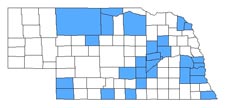
| Cicindela macra macra LeConte |
| Adult Length: 12 to 15 mm |
| Appearance: The dorsal surface is brownish to somewhat olive colored. Maculation on the elytra is generally quite sinuous, particularly the middle band and poshumeral mark. The humeral mark is normally very well developed and somewhat triangular in shape. The posthumeral mark extends at an angle toward the posterior and is upturned at the end. The middle band is usually somewhat reticulated on the inner side between the “foot” and the “knee”. The body shape is quite narrow in comparison with most other Nebraska tiger beetles. |
| Similar Species: This species is easily confused with C. cuprascens. It can be differentiated by its duller appearance as C. cuprascens is very shiny with an almost metallic luster. It might also be confused with C. hirticollis, but the posthumeral mark is distinctive. In C. macra the posthumeral mark extends at an angle toward the posterior and is partially re-curved at the end. In C. hirticollis the mark is also re-curved at the end, but initially extends laterally or even slightly toward the anterior. |
| Biology: This species occurs on river sandbars or rarely on lake beaches. It is usually not numerous, but can be numerous in localized areas. It is quite skittish, but is more easily captured on the wing than C. hirticollis. |
| Adult Life History: Adults emerge from the pupa in late June and July, and peak numbers occur in July. A few adults may survive into late August and September. It is a summer species. |
| Larval Life History: Little is known about the larval stages of this species. Its development is probably similar to that of the eastern C. puritana, whose larvae occur in both vertical sandy banks and on sandbars and beaches. The larval stage of C. puritana requires two years of development. |
| Biogeography: This species has been recorded from scattered locations across Nebraska. It appears to be consistent at some sites in the Loup River system and probably occurs in several counties within this river system from which it has not yet been recorded. At least one very large population which occurred along a small stream in Buffalo County was virtually eliminated by the construction of a small dam in 2003/2004. In North America it occurs from northern Texas and southeastern South Dakota east to southwestern Michigan and southern Indiana. Three subspecies have been described. |




